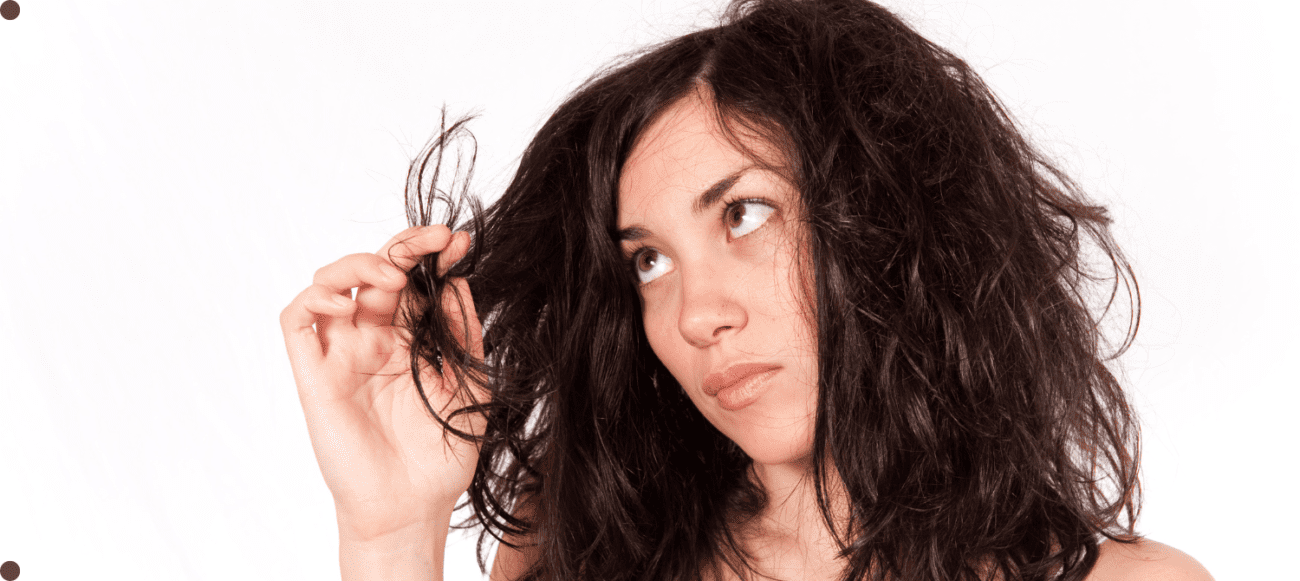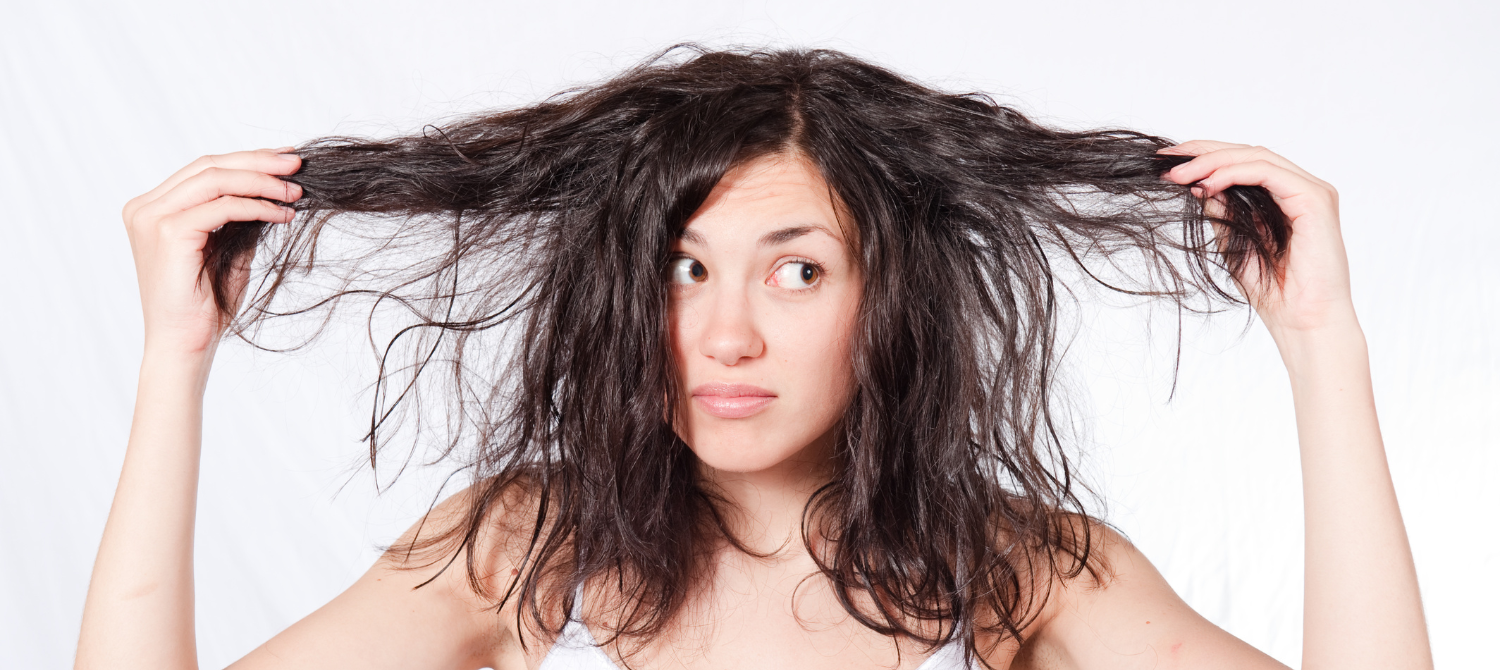What Causes Rough Hair Texture?
Rough hair texture can be caused by a variety of factors, both internal and external. Some of the most common causes include:
Genetics – Some people are simply born with coarser, thicker hair strands that feel rougher to the touch. Hair texture is largely determined by genetics, so if your parents have rough hair, you likely will too. Those of African descent tend to have the curliest, roughest hair.
Damage from heat styling and coloring – Frequent use of hot styling tools like blow dryers, flat irons and curling irons can damage hair over time, leaving it dry and frizzy. Coloring hair repeatedly can also wear down the cuticle layer, causing rough texture.
Dryness – Lack of moisture leads to cuticle damage and roughness. Dehydration, certain medications, nutrient deficiencies, hard water, and overwashing are common causes of dryness that can make hair rough.
Chemical treatments – Perms, relaxers and other chemical services break down bonds in the hair to change its structure. This takes a toll on the cuticle layer, resulting in coarse, damaged strands. Overprocessing causes the most roughness.
Problems Associated with Rough Hair
Rough hair texture can cause a number of styling and manageability issues. Some of the most common problems include:
Frizziness
The cuticle layer on rough hair tends to be more open and porous. This allows moisture to get in and out more easily, leading to frizziness and lackluster strands. Humidity and weather conditions make matters worse.
Flyaways
The coarse nature of rough hair means strands like to “stick out” in every direction. Trying to smooth down flyaways can be an exercise in frustration.
Tangling
Rough hair is prone to tangles and knots, especially at the ends. All that texture grabs onto itself and winds up in a big mess. Detangling requires time, patience, and a good conditioner.
Breakage
The texture of rough hair lends itself to snapping and breakage. Strands get hooked onto each other and pull apart easier than smooth hair. Regular trims are a must.
Hard to Style
Creating smooth styles can be nearly impossible with rough hair. The springy texture fights against flat irons, curling wands, and round brushes. Air drying often accentuates the worst characteristics.
Benefits of Solid Shampoo Bars
Solid shampoo bars provide a number of benefits compared to traditional liquid shampoos. Here are some of the main advantages of using shampoo bars:
Less packaging waste – Shampoo bars don’t come in plastic bottles, so they eliminate a significant source of plastic waste from your shower. Using shampoo bars is an easy way to reduce your environmental impact.
Portable for travel – Shampoo bars are very compact and travel-friendly. You don’t have to worry about liquid shampoo bottles leaking in your luggage. Shampoo bars are TSA-approved carry-on items.
Can customize ingredients – With shampoo bars, you can choose natural, organic ingredients that work best for your hair type. Many handmade shampoo bars allow you to avoid harsh chemicals found in some liquid shampoos.
Long-lasting – A single shampoo bar lasts for months of use, longer than a regular bottle of liquid shampoo. You get more value for your money. One bar eliminates the need for multiple plastic bottles over time.
Shampoo bars offer an eco-friendly and convenient alternative to regular bottled shampoo. They provide the cleansing you need while reducing unnecessary plastic waste. The customization, portability, and longevity of shampoo bars make them a great solution for those looking to make more sustainable choices.

Solid Shampoo Bars for Rough Hair.
Rough hair texture can feel dry, frizzy, and difficult to manage. The right shampoo is crucial for smoothing the cuticle and adding moisture. Solid shampoo bars formulated specifically for rough hair can help strengthen, soften, and add shine.
Look for bars containing moisturizing oils like coconut and argan oil. These oils can penetrate the hair shaft to improve hydration. Keratin proteins help reinforce hair fibers and reduce breakage associated with rough texture.
Avoid sulfates found in many liquid shampoos. Sulfates can strip natural oils and cause further dryness. Instead, opt for mild plant-based cleansers like those found in natural solid bars.
Essential oils like jojoba, olive, and avocado can increase shine and give hair a glossy look. Some solid shampoo recipes also incorporate botanical extracts with humectant properties to bind moisture to each strand.
With regular use, the right solid shampoo bar can make rough hair smoother, softer, and more manageable. The moisturizing oils and proteins nourish hair from root to tip for noticeable improvement over time.
Using Solid Shampoo Bars
Solid shampoo bars require a slightly different approach than bottled shampoos. Here are some tips for getting the most out of your solid shampoo bar:
Wet hair first – It’s important to wet your hair thoroughly before applying the shampoo bar. This helps the bar glide across your hair and scalp more easily. Apply the bar to wet, not dry, hair.
Rub bar directly on scalp – Focus on massaging the bar directly onto your scalp, rather than just the lengths of your hair. This helps stimulate the scalp and cleanse away dirt and oil at the root. Rub and lather the bar vigorously into your scalp.
Lather and rinse thoroughly – You’ll notice the bar produces a rich, creamy lather as you massage it in. Take your time to really work up a good lather. Then rinse very thoroughly to remove all traces of suds. It may take a couple additional rinses if your hair is thick.
Store bar dry – After each use, let your shampoo bar dry out completely before putting it away. This will help it last longer. Store it in a dry spot so it doesn’t get soggy between uses.
Solid shampoo bars take some getting used to, but many people prefer them over bottled shampoo once they get the technique down. Focus on massaging the bar into your wet scalp and rinsing thoroughly for best results. Your hair will feel fresh, clean, and healthy.
DIY Solid Shampoo Bar Recipes
Making your own solid shampoo bars at home is easy, customizable, and cost-effective. The base ingredients you’ll need are castile soap and coconut oil. Castile soap acts as a gentle cleanser while coconut oil helps add moisture and lather.
Some common additives to include are:
- Aloe Vera: Soothes the scalp and adds moisture
- Shea Butter: Softens hair and provides thickness
- Essential Oils: Add natural fragrance like lavender, peppermint, tea tree oil
Here is a simple DIY recipe:
Simple Shampoo Bar
- 1/2 cup castile soap flakes
- 1/4 cup coconut oil
- 1 tablespoon aloe vera gel
- 1 teaspoon vitamin E oil
- 10 drops essential oil of choice
Melt the soap flakes and coconut oil in a double boiler. Remove from heat and stir in remaining ingredients. Pour into silicone molds and let harden completely before removing.
You can customize this with different additives and essential oil blends. Reduce coconut oil for drier hair or increase for oilier hair. Experiment with small batches to create your own perfect solid shampoo bar!
Lathering Tips for Solid Bars
Properly lathering solid shampoo bars is crucial for cleansing rough hair. Here are some tips:
Focus on massaging the bar directly into your scalp. The scalp is where product buildup and oil accumulate, so concentrating on scrubbing the bar over your scalp will create a rich lather.
Use a shampoo brush or your fingertips to work the bar in and lift dirt from your strands. The gentle friction from the brush bristles helps activate the shampoo.
Rinse and repeat if needed. Some people find their hair needs two rounds of lathering and rinsing to fully cleanse with a bar. Apply the bar again if your hair still feels dirty after the first wash.
Let the bar sit and melt slightly in your hands before applying. This helps release the shampoo so it spreads more easily through your hair.
Add water gradually as you rub the bar. Start with damp hair, then add small amounts of water to build up lather. Too much water right away can dilute it.
Give it time. It may take 30-60 seconds of scrubbing before you work up a good lather. Be patient and keep working the bar all over.
Try rotating 2-3 bars. Switching between a few bars gives each one time to dry out between uses, helping them last longer.
With some practice, you’ll get your solid shampoo lathering like a pro in no time!
Proper Storage for Solid Bars
Properly storing your solid shampoo bar is important to keep it clean and make it last longer. Here are some tips:
Allow the bar to dry fully after each use before putting it away. Don’t seal it up while still wet, as this can cause mold growth. Let it air dry on a soap dish or rack.
Store in a dry, well-ventilated area. Bathrooms can be humid, so store it in a cabinet or drawer if possible. Keeping it in an open container is ideal.
Use clean hands when handling the bar. Try not to get it too wet or drop it on wet surfaces. Oils and dirt from hands can transfer to the bar and make it get used up faster.
If your bar didn’t come in a tin or wrapped, consider wrapping it in paper or putting it in a container with holes for airflow. This protects it from contaminants.
Don’t let it sit in water. After use, let excess water drip off before setting it in the dish to dry. Prolonged water exposure can ruin the bar.
Following these simple storage guidelines will help your natural shampoo bar last longer and stay fresher. With proper care, it can be an eco-friendly hair washing solution for months.
Transitioning to Solid Shampoo Bars
Switching to solid shampoo bars can take some adjustment, especially if you’re used to the feel of traditional liquid shampoos. Many find that their hair feels different at first when using the bars – slightly drier or not as slick. This is normal and does not mean the bars are not working. It simply takes time for your hair to adapt to the change in formula and ingredients.
The key is to be patient and consistent. When first starting out with bars, try alternating use with your regular shampoo rather than switching completely overnight. Use the bars once or twice a week for the first couple weeks, then increase frequency from there. Give your hair 2-4 weeks to adjust to this new routine. In most cases, hair will bounce back after the initial transition period. The bars’ natural oils and butters will help moisturize and condition hair over time.
Stick with it and know that the odd feeling at first is temporary. Before you know it, your hair will look and feel great using these all-natural, plastic-free bars. Making the switch is worth it for your hair and the planet.
Frequently Asked Questions
Will it clean as well as liquid shampoo?
Solid shampoo bars are just as effective at cleansing as liquid shampoos. The soap molecules in bars are able to lift dirt, oil, and product buildup from the hair and scalp. Bars create a rich lather that penetrates the hair shaft to deeply cleanse. They may even clean better than liquid shampoos since there are no fillers or diluting water.
How long do bars last?
On average, one 3-5 ounce bar will last 4-6 weeks with regular use. This is comparable to a 16-24 ounce bottle of liquid shampoo. Factors like hair thickness and washing frequency impact bar longevity. Those with thick or long hair may get 2-4 weeks from a bar.
Will it dry out my hair?
No, bars will not dry out the hair. They still contain gentle cleansers and oils that nourish the hair. Opt for bars with moisturizing ingredients like shea butter, coconut oil, and olive oil. These ingredients coat the hair shaft to lock in moisture and prevent dryness.
Can I travel with bars?
Yes, shampoo bars are great for travel since they reduce plastic waste and liquid leakage. Wrap bars in wax paper or reusable silicone bags. Store in a soap travel case or small container. The solid format prevents spills or messes. TSA allows carry-on bars.
Our Hair Care Products For Dandruff
 Rated 0 out of 5¡A la Venta!Add to basket
Rated 0 out of 5¡A la Venta!Add to basket$10.00Original price was: $10.00.$5.99Current price is: $5.99. Rated 0 out of 5¡A la Venta!Add to basket
Rated 0 out of 5¡A la Venta!Add to basket$10.00Original price was: $10.00.$5.99Current price is: $5.99. Rated 0 out of 5¡A la Venta!Add to basket
Rated 0 out of 5¡A la Venta!Add to basket$10.00Original price was: $10.00.$5.99Current price is: $5.99. Rated 0 out of 5¡A la Venta!Add to basket
Rated 0 out of 5¡A la Venta!Add to basket$10.00Original price was: $10.00.$5.99Current price is: $5.99.


